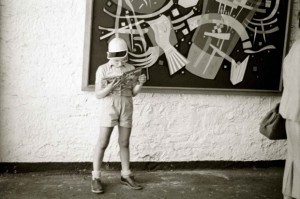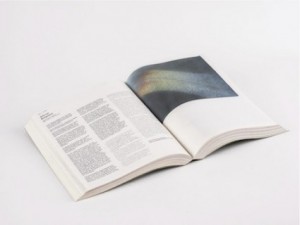Not All Documents Are Records — Reviewed
Is it art? Or a document of art? Where does the overlap lie? Mike Pinnington enjoys exploring the nuance of meaning at Open Eye Gallery’s Biennial exhibition…
The measure of success for an exhibition can often be boiled down to one thing: does it answer the question(s) it poses or satisfy that which it sets out to explore? In the case of the Open Eye Gallery’s Liverpool Biennial contribution Not All Documents Are Records: Photographing Exhibitions as an Art Form, this is literal, for in the exhibition guide we are asked the following: ‘Can photography produce the history of an art exhibition and still retain its artistic autonomy?’
Of course, speaking so overtly about interrogations at the heart of an exhibition exposes the show and its curators (in this case, Open Eye Artistic Director Lorenzo Fusi), and reveals a degree of confidence. But, what if the answer delivered doesn’t cohere with the show? Worse still, what if the exhibition fails in providing any answers at all?
The exhibition uses three arts festivals as case studies: documenta 2, the 1968 Venice Biennale, and Liverpool’s own Biennial. In the first gallery space – somewhat boldly (a tendency for this exhibition) – Cristina de Middel presents, for want of a better description, non-works. Unable to get permission from several past-Biennial artists to reference their work in this show, the artworks that would usually take centre stage have been cut-out, erased; leaving only the image around them.
Formerly a photojournalist, De Middel meets some of those earlier questions head-on with nary a flinch and introduces yet more for good measure; around appropriation, authenticity and, perhaps, what happens when Biennial works vacate these spaces. What they also do however, can’t fail to do, is force us to recall or imagine the thing that is no longer there. Beyond those mental leaps, De Middel’s work sometimes becomes a focus on what isn’t there, ultimately, to an extent, leaving the images wanting.

In the next space we are met with a degree of theatre, in the form of placards, bearing legends such as “The biennale is fascist”, and “Visit the police at the biennale”. This is Ugo Mulas’ record of the 1968 Venice Biennale, also known as ‘the biennial of the police’. It serves as a window on to the politics of the time; one of popular uprising with the unmistakable whiff of revolution in the air, making Venice Biennale the crucible of public demonstration, where artists withdrew or veiled their works.
Alongside the private views, talks and artworks, Mulas’ lens captures the protests, and therefore the tensions, anxieties and uncertainty, not only on the faces of many people in the pictures, but also of the times.
The upstairs gallery is shared by two very different practices. Hans Haacke’s work demands attention. Offering a counterpoint to the works of De Middel and Mulas (and indeed Ira Lombardia, more on her later) Haacke’s photographs, rather than interested in questions of subversion, or capturing a society in the throes of sedition, are manifestations of how an audience gives life to artworks. After all, how can a work be a masterpiece until its audience deems it so?
Fittingly, documenta 2 (1959), from this evidence, was a vintage year: Haacke augments Kandinsky, Klee, Mondrian, Magritte and Pollock, capturing audience responses to the works on display. The relationship, this back and forth, is represented in the titles Haacke gives the works: such as Kandinsky Mickey Mouse (of a young boy reading a comic, completely ignoring the huge Kandinsky behind him), or Magritte 2 Profiles (an elderly couple – Magritte and his wife? – simultaneously look away in front of a startling portrait). Apart from illustrating the fleeting potential for symbiosis between work and respondent, Haacke’s images elicit pure joy.

How to follow pure joy? Madrileña Ira Lombardia introduces genuine mischief and curiosity. In a vitrine, alongside what appears to be the official exhibition catalogue for documenta 13, is another publication, open at a page which begins: “My name is Iraida Lombardia, and I’m a criminal of sorts.” It could be the first line of a cold war thriller, but Lombardia’s crime isn’t one of duplicitous saboteur, and yet it isn’t far off.
Visiting documenta 13 in 2012, Lombardia’s witnessing of sun streaming through the windows inspired a “vision”. This vision, created by the sun’s intrusion into the gallery, moved Lombardia to imagine it as a piece of artwork alongside the rest, and she would subsequently include this “work” and its fictional creator in the exhibition catalogue. It’s a wonderful conceit. Amid those Haacke’s however, one which might go missing without the luxury of hearing Lombardia herself describe the incident and the following counterfeit catalogue entry at the expense of some unfortunate authentic ones. This isn’t a failure of Lombardia’s, more a failure of successfully displaying a non-traditional work such as this. It’s not straightforward.
De Middel, Mulas, Haacke and Lombardia are photographers – artists – providing historical, social and political context, and more still, resoundingly answering the question posed at the the start: ‘Can photography produce the history of an art exhibition and still retain its artistic autonomy?’ You bet, and for proof you need look no further than Not All Documents Are Records: Photographing Exhibitions as an Art Form.
Mike Pinnington
Read our other Biennial 2014 articles here
Liverpool Biennial continues until 26 October. Look out for talks, fringe events and performances on the site – www.biennial.com/2014
Images: Main: Ugo Mulas, Venezia, 1968. Proteste studentesche, XXXIV Esposizione Biennale Internazionale d’Arte, “Photo Ugo Mulas © Ugo Mulas Heirs. All rights reserved,” courtesy camera16 contemporary art
Centre: Hans Haacke, Kandinsky Mickey Mouse, 1959. Ira Lombardia, And I Think to my selffffffffff what a wonderful worlllllllllld, 2012





